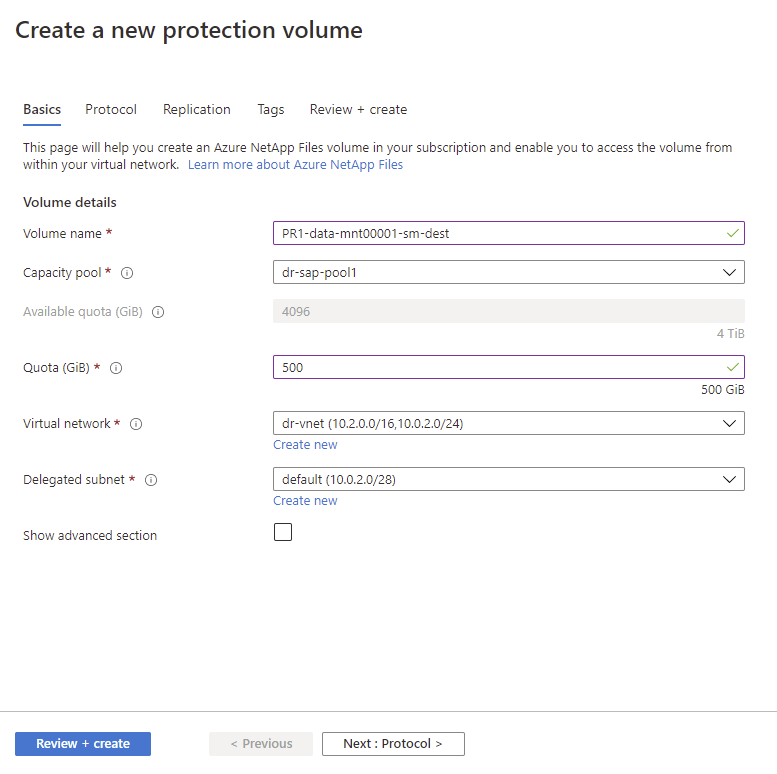Configuration steps for ANF Cross-Region Replication
 Suggest changes
Suggest changes


A few preparation steps must be performed at the disaster recovery site before volume replication can be configured.
-
A NetApp account must be available and configured with the same Azure subscription as the source.
-
A capacity pool must be available and configured using the above NetApp account.
-
A virtual network must be available and configured.
-
Within the virtual network, a delegated subnet must be available and configured for use with ANF.
Protection volumes can now be created for the HANA data, the HANA shared and the HANA log backup volume. The following table shows the configured destination volumes in our lab setup.

|
To achieve the best latency, the volumes must be placed close to the VMs that run the SAP HANA in case of a disaster failover. Therefore, the same pinning process is required for the DR volumes as for any other SAP HANA production system. |
| HANA volume | Source | Destination | Replication schedule |
|---|---|---|---|
HANA data volume |
PR1-data-mnt00001 |
PR1-data-mnt00001-sm-dest |
Daily |
HANA shared volume |
PR1-shared |
PR1-shared-sm-dest |
Hourly |
HANA log/catalog backup volume |
hanabackup |
hanabackup-sm-dest |
Hourly |
For each volume, the following steps must be performed:
-
Create a new protection volume at the DR site:
-
Provide the volume name, capacity pool, quota, and network information.
-
Provide the protocol and volume access information.
-
Provide the source volume ID and a replication schedule.
-
Create a target volume.
-
-
Authorize replication at the source volume.
-
Provide the target volume ID.
-
The following screenshots show the configuration steps in detail.
At the disaster recovery site, a new protection volume is created by selecting volumes and clicking Add Data Replication. Within the Basics tab, you must provide the volume name, capacity pool and network information.

|
The quota of the volume can be set based on capacity requirements, because volume performance does not have an effect on the replication process. In the case of a disaster recovery failover, the quota must be adjusted to fulfill the real performance requirements. |

|
If the capacity pool has been configured with manual QoS, you can configure the throughput in addition to the capacity requirements. Same as above, you can configure the throughput with a low value during normal operation and increase it in case of a disaster recovery failover. |

In the Protocol tab, you must provide the network protocol, the network path, and the export policy.

|
The protocol must be the same as the protocol used for the source volume. |

Within the Replication tab, you must configure the source volume ID and the replication schedule. For data volume replication, we configured a daily replication schedule for our lab setup.

|
The source volume ID can be copied from the Properties screen of the source volume. |

As a final step, you must authorize replication at the source volume by providing the ID of the target volume.

|
You can copy the destination volume ID from the Properties screen of the destination volume. |

The same steps must be performed for the HANA shared and the log backup volume.



 Best Practices
Best Practices
